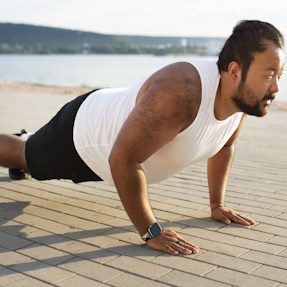
How to overcome the challenges of exercising when obese
It is widely accepted that individuals who maintain an active lifestyle are generally healthier and less likely to suffer from chronic illnesses, whether overweight or obese. These individuals are aware that exercise can aid them in achieving a healthier weight and improving their overall health and well-being. However, starting an exercise regimen can be daunting in various ways.
Many people who are overweight often receive warnings about the potential health risks associated with their excess weight, including heart disease, diabetes, high blood pressure, chronic kidney disease, and certain forms of cancer. They may also experience added stress and strain on their hip and knee joints. However, for those not in that situation, it can be challenging to comprehend the difficulties of exercising. At the same time, overweight or obese and how simply moving around can be difficult.
Many people want to improve their physical fitness and overall health, but struggle for various reasons. The challenges they face in incorporating exercise into their daily routine include:
Going to a gym is intimidating
Even individuals who regularly exercise can find going to a gym intimidating. For those who have not worked out in a while and are significantly overweight compared to others at the gym, the experience can be even more intimidating. Such individuals are likely to feel embarrassed or discouraged, which could make it difficult for them even to consider showing up.
Getting into a swimsuit can be unnerving
Regardless of their level of physical fitness, many individuals feel uneasy about wearing a swimsuit and being observed by others while doing so. However, for those who are classified as overweight or obese, it may require a considerable amount of courage to take this step.
Swimming is an excellent exercise, especially for those who experience joint problems due to excess weight. However, the prospect of wearing a bathing suit may induce panic in some individuals, preventing them from attempting to exercise.
Exercise equipment may not “fit” someone large
Exercise equipment is often designed for individuals who are already physically fit, so it can be difficult for those with a larger frame to find suitable equipment. Weight benches are often too narrow for larger individuals and many strength machines have seats that are too small for those with larger hips. Even recumbent bikes, which are an excellent option for overweight individuals, often have too small seats.
Participating in a group can be challenging
Many gyms provide group exercise classes that may be challenging for bigger individuals. Certain movements such as getting up and down from the floor can be strenuous, and supine exercises can lead to breathing difficulties. If someone larger has joint problems, performing squats or lunges may not be feasible. Additionally, executing balance exercises can be quite hard.
5 ideas on making exercise happen when overweight or obese
- If you are overweight or obese and want to start an exercise program, getting clearance from your doctor first is essential. While most doctors will encourage you to exercise, it’s a good idea to have medical supervision, especially in the beginning. Your doctor may refer you to a team of experts to help you achieve your weight loss and fitness goals, such as a certified athletic trainer, exercise physiologist, registered dietitian, or endocrinologist. These professionals can work together to help you reach a healthier body weight.
- For obese individuals, it is suggested to begin with low-intensity aerobic exercises such as stationary cycling, recumbent cycling, seated stepping, seated aerobics, and water aerobics. Starting slowly can be beneficial for the individual.
- For those who feel intimidated to exercise alone at a gym, working with a personal trainer is a great option. This provides one-on-one attention on specific exercises tailored to each individual’s needs and goals. Meeting with a personal trainer in private can be more motivating and help maintain a consistent exercise routine. It’s an excellent way to achieve weight loss and improve overall health.
- For many people, starting with walking is a great exercise option. To increase the amount of walking throughout the day, using a pedometer can be helpful. One effective way to challenge oneself is to beat the number of steps taken the previous day. Those who have office jobs and spend most of their day sitting can aim to take at least 50 steps every hour while at work. Setting a timer to go off every hour can serve as a reminder to take a quick walk and get in the required steps.
- If you like exercising at home, you can find online personal training sites that offer a personal trainer to help you create a workout plan. Additionally, YouTube has numerous free exercise videos that cover a range of exercises from aerobics to spot reduction to weightlifting. If you consistently follow these videos, they can be very effective.
Take home message
If you want to lose weight and improve your overall health, consistency is crucial. Obese and overweight individuals can successfully achieve their weight loss goals by establishing a regular, enjoyable, and consistent exercise routine.
Dr. David Samadi is the Director of Men’s Health and Urologic Oncology at St. Francis Hospital in Long Island. He’s a renowned and highly successful board certified Urologic Oncologist Expert and Robotic Surgeon in New York City, regarded as one of the leading prostate surgeons in the U.S., with a vast expertise in prostate cancer treatment and Robotic-Assisted Laparoscopic Prostatectomy. Dr. Samadi is a medical contributor to NewsMax TV and is also the author of The Ultimate MANual, Dr. Samadi’s Guide to Men’s Health and Wellness, available online both on Amazon and Barnes & Noble. Visit Dr. Samadi’s websites at robotic oncolo gy and prostate cancer 911.
